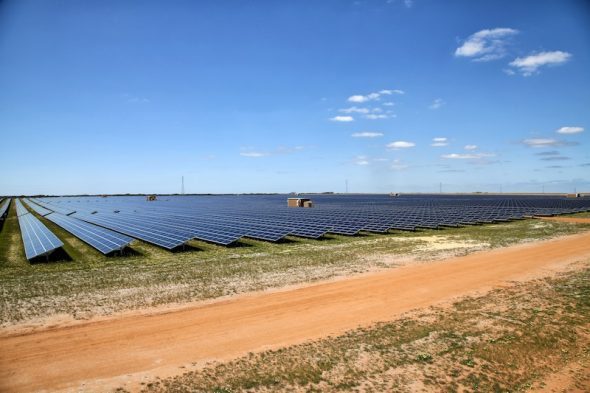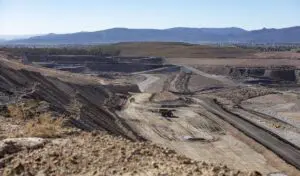At about 11am local time near the Western Australian town of Geraldton this morning, Australia’s first-utility scale solar farm was officially switched on.
It was a suitably sunny day (blighted by three million flies) and although just 10MW in size, and built courtesy of funding from the local government, a state-owned utility and by one of the wealthiest companies on the planet, it may presage a dramatic change in the way this country produces energy.
For the last 100 years or so, Australian power companies have produced energy by burning something – mostly coal, sometimes gas, and occasionally sugar cane and other agricultural or forestry waste – to create steam and drive a turbine. Even with the advent of wind energy, this is the first large-scale energy plant that does not involve a rotating machine. It does not need water either, and it makes no emissions.
The 150,000 solar photovoltaic panels installed at the Greenough River solar farm, about 50km south-east of Geraldton, converts sunlight into direct current electricity via thin-film PV solar cells made by First Solar, which is then converted by inverters into alternating current suitable for feeding into the grid.
While this is the first utility-scale solar PV farm in Australia, and 10 times bigger than the next biggest solar installation in the country, the country trails far behind Europe, North America, China and other parts of Asia in the rollout of these sorts of plants. If it had been built in 2005, this plant would have ranked as the biggest in the world, but such has been the pace of development in the solar industry that Greenough River does not even rank in the top 200 solar farms in the world.
Nevertheless, solar PV is expected to become one of the critical sources of energy in the future in Australia.
“It seems amazing that a country this size has taken this long to install its first solar plant,” said Verve Energy CEO Jason Waters at the opening ceremony. “It certainly won’t be last given success of this project.”
Verve Energy, which owns a bunch of coal-fired generators, as well as gas and is investing in wind farms, said the Greenough River Solar Farm demonstrated that “renewable technologies can contribute to meeting Australia’s future energy needs on a sustainable, cost-competitive basis.” Waters said: “This is a positive first step in validating the bright future that large-scale solar represents in Australia.”
Matt O’Connor, managing director of GE Energy Financial Services, which invests $2-$3 billion a year in energy projects each year, agrees. “We see incredible investment opportunities in Australia and look forward to expanding on this successful project and applying our expertise to help the country’s renewable energy market grow.”
How much will that be? The recent technology assessment by the usually conservative Bureau of Resource Economics and Energy said solar PV would be unequivocally the cheapest form of new-build generation by 2030, and even now the best sites might be cheaper than coal or gas.
In light of these forecasts, it will be interesting to see what the Energy White Paper predicts in its scenarios when that document is released later this month. Its draft version, relying on technology cost estimates that proved hopelessly wrong, predicted only a 3 per cent role by 2050.
Private forecasts suggest that solar PV could provide 20 per cent more of the country’s electricity in a zero carbon scenario (the rest would come from an equal amount of solar thermal – with storage, with about half coming from wind and the rest in the form of gas-fired generation). That would require some 20,000 to 30,000MW of solar PV installed across the country over the next few decades. Jack Curtis from First Solar says there could be 3,000MW to 5,000MW of utility-scale solar by 2020. (see separate story)
The International Energy Agency – in its Solar Energy Perspectives document produced last year – said solar could form the backbone of the world’s electricity market, and said solar PV could account for 20 per cent of global capacity by 2050 – or about 12 million MW (12,000GW). That compares to around 40GW now.
The joint owners of the Greenough River Solar Farm are already considering expanding the project to 40MW. GE Financial Services and Verve Energy say, however, that no decisions have been taken. It will rely on a power purchase agreement being signed by the local utility, which is using the 10MW first stage as a contribution to the energy needs of its desalination plant, and it would likely need banks to get involved.
The good news is that one Australian bank, the Commonwealth Bank, last week provided its first loan for a solar project in Australia, albeit a small one, for the 1MW Uterne solar PV tracking facility in Alice Springs. Mark Widmar, the CFO of First Solar who flew out to Geraldton for the opening, told RenewEconomy that having met representatives of all four major banks in Melbourne this week, that the appetite was there. “They clearly want an opportunity to play in this market, “ he says. And Greenough River will provide crucial data for those financing assessments.
Apart from the Greenough River solar farm, and its anticipated expansion, First Solar also has a contract to supply panels to the 159MW project being built by AGL Energy at Nyngan and Broken Hill in NSW, although this project, with funding from the now defunct Solar Flagships scheme, will not begin construction until 2014.
The next new solar PV project to be built in Australia is expected to be the 20MW solar farm to be built by Spanish group FRV, after it won the ACT government’s reverse tender last month. Infigen Energy is building a 1MW project near Bungendore, the first to combine solar PV and battery storage in a plant recognised by the National Electricity Market, while Infigen, the Moree solar consortium and other groups have applied for funding from the newly established Australian Renewable Energy Agency is scaled down versions of the flagships applications. The investment bank Investec is also considering a solar PV project in WA, which enjoys the richest resource of solar in the country, and the highest energy costs.
It is ironic to note that the Greenough River farm was developed because WA government was determined to have a slice of the Solar Flagships scheme, but its plans did not qualify. The Rudd government wanted only massive projects of 250MW, later diluted to a slightly more palatable 150MW. That would not have been possible in regional WA because of grid issues. The irony is that this project is built, while construction on the flagships projects will not commence for another two years. It highlights what a wasted opportunity the flagships program was.
Even so, the WA government is not quite as excited about the opportunities as it might have been. WA Premier Colin Barnett is opposing the 41,000GWh fixed renewable energy target, and energy minister Peter Collier, while praising solar at the opening of the Greenough River Faarm today, was also hedging his bets about the future of the LRET. WA has nearly doubled its renewable energy penetration from around 5 per cent to just over 9 per cent, but it would need to do a lot to meet 20 per cent. But he did notice the swarms of flies. “They must all be greenies,” he quipped.












